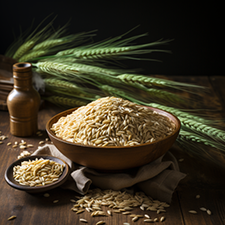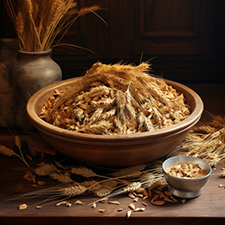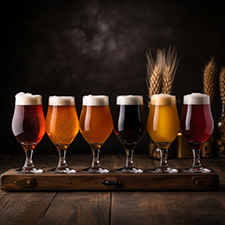The Sweet Science: How to Account for Sugar Variability in Grains for Beer Making
Posted by Matteo Lahm on 10th Jan 2024
Sugars in grains make your favorite brews possible, but they're also a source of great variability and potential confusion. So, let's dive into the sweet world of sugars in grains and understand how they can affect your beer-making process and the final alcohol by volume (ABV) of your brew. It is important to know the starch by weight of various grains as well as the protein content to correctly portion your grains during the mash and anticipate your ABV. There are also other factors that affect fermentable sugar extraction that might not be measurable on your hydrometer depending on the type of grain you are using.

The first thing to understand is that not all grains are created equal. They can vary significantly in their sugar content, and this variability can have a profound impact on the brewing process. For instance, barley, the most commonly used grain in beer making, typically contains about 65-70% starch by weight. This starch is converted into fermentable sugars during the mashing process, which yeast then ferments into alcohol.
However, other grains like wheat, rye, oats, and corn can have different starch contents and therefore produce different amounts of sugar. Wheat, a popular choice for many brewers, particularly in the production of wheat beers and Hefeweizens, typically contains around 60-65% starch by weight. This is slightly less than barley's 65-70%. The higher protein content in wheat, around 12-15% compared to barley's 10-12%, can indeed lead to a lower sugar yield. However, this higher protein content also contributes to a fuller mouthfeel and a characteristic cloudy appearance in the final beer. So, if you are making a wheat beer, your wort will have less fermentable sugar not only because the starch by weight is lower but also, less sugar will be extracted because of the higher protein content.
Rye, while offering a unique and desirable spicy flavor profile, can be a bit more of a handful in the brewing process due to its distinct composition. With a starch content similar to wheat, around 60-62% by weight, rye could seem like a straightforward substitute. However, the devil is in the details, and in this case, the detail is beta-glucans.
Beta-glucans are a type of soluble fiber found in higher concentrations in rye compared to other grains. While they have health benefits when included in our diet, in the brewing process, they can present a challenge. These beta-glucans increase the viscosity of the mash, making it thicker and more prone to creating a 'stuck mash.' This is a situation brewers want to avoid as it can halt the brewing process, making it difficult to separate the liquid wort from the grain husks. Moreover, the high beta-glucan content can also lead to a hazy appearance in the final beer, which may not be desirable in certain beer styles.

Despite these challenges, many brewers are drawn to rye for its unique contribution to flavor. The distinct spicy or grainy notes it imparts can add complexity and depth to a beer, making the extra effort worthwhile. Therefore, while rye requires careful handling and consideration in the brewing process, it can be a rewarding grain to work with for those willing to take on the challenge.
Oats, often used in smaller quantities in styles like Oatmeal Stouts, contain around 55-60% starch by weight. Their higher fat and protein content (15-18% and 12-24% respectively) can contribute to a smoother mouthfeel and a rich, creamy head, but can also result in a lower sugar yield.
Finally, corn, often used in American lagers, contains a higher starch content of around 70-75% by weight. This can lead to a higher sugar yield, making it an economical choice for increasing the alcohol content without significantly affecting the flavor. However, corn's lower protein content (around 8-10%) can result in a beer with less body which is why corn is often used only as an adjunct.
In summary, each grain brings its unique starch and protein composition to the table, influencing not only the sugar yield and potential alcohol content but also the flavor, appearance, and mouthfeel of the final beer. Therefore, understanding these differences is crucial for brewers aiming to achieve specific characteristics in their brews.
The type of grain isn't the only factor that can affect sugar content. The specific variety of grain, its growing conditions, and how it's malted can all influence the amount of sugar it produces. Even the same variety of grain can produce different amounts of sugar from year to year or from field to field.

So, what does all this mean for calculating ABV? Well, it means that you can't just assume a certain amount of sugar from a certain amount of grain. You need to measure the specific gravity of your wort (the liquid extracted from the mashing process) before and after fermentation. This will tell you how much sugar was in the wort and how much has been converted into alcohol, allowing you to calculate the ABV accurately.
But here's where things can get tricky. The efficiency of the mashing process can vary, meaning that not all the starch in the grain will be converted into fermentable sugar. This can be affected by factors such as the temperature and pH of the mash, the crush of the grain, and the length of the mash.
So, you need to be aware of these variables and how they can affect your brewing process. You need to measure, adjust, and experiment to get the results you want. And remember, while sugar is a crucial component of beer, it's not the only one. The type and amount of hops, the strain of yeast, and other factors also play a significant role in the final flavor, aroma, and mouthfeel of your beer.
In conclusion, the variability of sugars and potential extraction in different grains are a complex issue that can significantly impact the brewing process and the final ABV of your beer. But with careful measurement, attention to detail, and a willingness to experiment, you can harness this variability to create a wide range of delicious and unique beers. So, embrace the sweet science of brewing and let your creativity flow!

